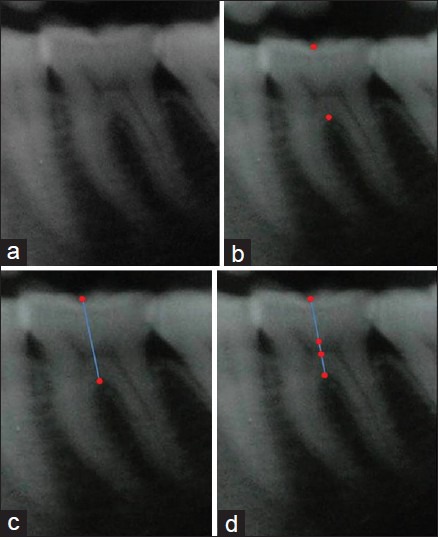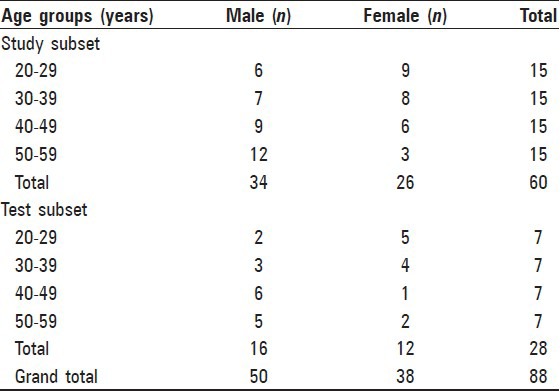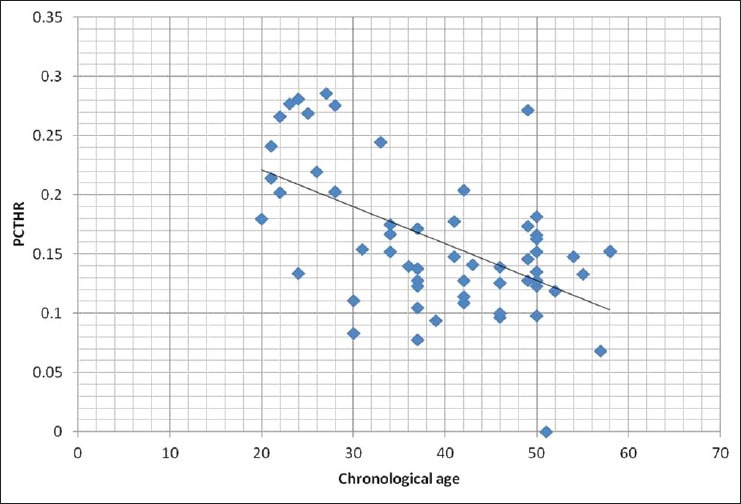Abstract
Objective:
To develop an independent procedure for estimating age for Indian individuals using radiographs of multi-rooted posterior teeth with accuracy needed in forensic age prediction.
Materials and Methods:
Orthopantomography (OPG) was obtained for 88 subjects. The subjects were divided into two sub sets; study subset (n = 60) which were used to find regression formula to calculate the age from pulp chamber height and test subset (n = 28) which were used to test the accuracy of this formula.
Results:
There was a statistically significant strong correlation between chronological age and pulp chamber crown root trunk height ratio (r = −0.56; P = 0.000). The regression equation for estimating the age, derived from the study subset was estimated age = −100.920 (PCTHR) +55.415. (PCTHR is the pulp chamber crown root trunk height ratio). This equation was applied on the test subset and there was no significant difference between estimated ages and chronological ages (P = 0.639). The mean absolute error (MAE) was 6.96 years, which was within acceptable error limits for forensic age estimation (<±10 years).
Conclusion:
The procedure developed to estimate the age using height reduction in pulp chamber was found to be fairly accurate to perform forensic age prediction in Indian individuals.
Keywords: Age estimation, pulp chamber height, secondary dentine
Introduction
Age estimation of has to be done in both living and dead individual's for legal procedures, to identify victims during mass disasters, and for anthropological studies.[1] In deceased individual's age estimation; post-mortem environment can modify the body parts and render estimation difficult. When different parts of the body used for age estimation were compared, tooth was found to be the most durable and least affected by post-mortem changes.[2]
Age estimation in children can be done by studying the stages of tooth development and eruption. In adults, age estimation with tooth has to be done by the analysis of cementum annulations, root transparency and determination of aspartic acid racemisation. However these techniques are invasive and require tooth extraction, which is not possible in living individuals.[3] After root completion; secondary dentine is deposited throughout one's life reducing the pulp chamber. It is known that size of the pulp chamber reduces as the chronological age advances and its least influenced by other environmental factors.[4]
Non-invasive radiographic techniques have been developed for studying the amount of secondary dentine deposited by measuring the pulp chamber size reduction. This reduction in pulp chamber was correlated with chronological age and regression equations were derived to estimate the age.[2,5] Cameriere et al.,[2] formed age predicting regression equations using pulp tooth area ratio in mandibular canines. They were able to obtain a high level of accuracy in their age prediction using this regression equation in an Italian sample (mean error 3-4.5 years). When Cameriere et al.'s technique was used to derive an Indian specific equation, the mean absolute error of the predicted age was found to be more than 10 years. Errors lesser than ±10 years are only considered to be acceptable in forensic age prediction.[6,7] Saxena[1] obtained better accuracy in age prediction with Indian subjects using modified Kvaal's method; a technique based on linear measurements of pulp. However, all these current age estimation techniques developed for Indian population uses anterior teeth which are often absent in elderly.[5]
The aim of the present study was to develop an independent procedure to estimate age for Indian individuals using radiographs of multi-rooted posterior teeth with acceptable error margins for forensic age prediction (±10 years).
Materials and Methods
Subject selection
Orthopantomography (OPG) was obtained for 88 subjects and they were digitalized using scanner (Umax™). The subjects were divided into two subsets. The first subset; study subset (n = 60) was used to find regression formula to calculate the age from pulp chamber height. The second subset; test subset (n = 28) was used to test the accuracy of this formula. The age of the subjects ranged from twenty to sixty. The subjects in each subset were grouped into 3rd decade (20-29 years), 4th decade (30-39 years), 5th decade (40-49 years), 6th decade (50-59 years). In the study subset, each group had 15 subjects and in test subset each group had seven subjects.
In each OPG a mandibular first molar was randomly selected. Root canal treated teeth, impacted teeth, teeth with visible periapical pathologies, caries, attrition, radio-opaque fillings and crowns were excluded from the study. The study was approved by an Institutional Review Board.
Radiograph measurements
Adobe Photoshop CS5™ program was used to mark the points and record measurements in the digitalised OPG's. Points were marked on the central fossa and the highest point on the root furcation and a line was drawn connecting these lines. The points on the roof and floor of pulp chamber bisecting this line were also marked. The distance between the central fossa and the highest point on the root furcation was recorded as crown root trunk height (CRTH) and the distance between points on the roof and floor of pulp chamber was recorded as pulp chamber height (PCH) [Figure 1]. A ratio is derived between pulp chamber height and crown root trunk height; pulp chamber crown root trunk height ratio (PCH/CRTH = PCTHR) in order to avoid projection error.[1,6] All measurements were recorded by a single observer and twenty randomly selected radiographs were measured after one month to access intra observer agreement.
Figure 1.

Steps in measuring the crown root trunk height and pulp chamber height. (a) A first molar radiograph, (b) points marked on the central fossa and the highest point on the root furcation. (c) A line drawn connecting these points. (d) Points on the roof and floor of pulp chamber bisecting this line marked
Statistical analysis
All data were entered and analysed using SPSS (Statistical package for social science) v11.5TM. In the study subset Pearson correlation was done between chronological age and pulp chamber crown root trunk height ratio. Regression analysis was done on PCTHR and a formula was derived to estimate the age. The regression equation was applied on the test subset to test its accuracy in age prediction. The difference between the chronological age and estimated age was recorded as error. Independent samples t-test was performed between chronological age and estimated age in the test subset; for total subjects and male and female subjects separately. Mean absolute error (MAE) was derived by calculating the mean of absolute value of the errors. Percentage of cases with the calculated age < ± MAE and those falling within < ±10 years; the error acceptable in forensic age prediction were calculated.[6,8] The intra observer reliability was assessed by inter class correlation co-efficient. A P < 0.05 was considered to be statistically significant.
Results
Orthopantomography (OPG) of 88 subjects was used for the study. There were 50 male and 38 female subjects in the study [Table 1].
Table 1.
Distribution of subjects in study and test subsets

A statistically significant negative correlation was found between chronological age and pulp chamber crown root trunk height ratio (r = −0.56; P = 0.000) [Figure 2]. Regression analysis on the test sample produced the following linear regression equation;
Figure 2.

Scatter plot distribution of the pulp chamber height crown root trunk height ratio when compared to the subject's chronological age
Estimated age = −100.920 (PCTHR) + 55.415. (PCTHR is the pulp chamber crown root trunk height ratio). The R2 value for the regression equation is 0.313.
The equation was applied on the test subset and age was calculated. No significant difference was found between the actual age and calculated age (P = 0.639) [Table 2]. MAE was estimated by applying the equation on the test sample and was found to be 6.96 years. The percentage of estimated ages in test samples <± MAE was 57.14% (16/28) and those falling within <±10 years; the error acceptable in forensic age prediction was 71.4% (20/28).
Table 2.
Mean difference between actual age and calculated age in test subset

There was no significant difference between the actual age and calculated age in males (P = 0.947) and females (P = 0.424) [Table 2].
There was a significant intra observer reliability in the measurement of crown root trunk height [r = 0.9584, P = 0.000, 95% CI (0.890-0.9833)] and pulp chamber height [r = 0.6972, P = 0.002, 95% CI (0.3786-0.8681)].
Discussion
Tooth is considered as a reliable body part for forensic age estimation since environment has minimal influence on it. Age estimation by radiographic evaluation of secondary dentine deposition is an established non-invasive technique for adults.[9] Numerous accurate age estimation equations have been derived for western population using measurements of secondary dentine deposition, which when applied for Indian samples produced errors unacceptable in forensic age estimation. In order to enhance the accuracy of age prediction it is advocated to derive age estimating formulas specific to Indian population.[2,6,7]
The various studies that's been done to construct a formula for age estimation in Indian population has utilized radiographs of anterior teeth.[1,6,7,10] But in elderly anterior teeth are often lost making age estimation difficult.[5]
In our study, we have developed an independent procedure utilizing radiographs of mandibular first molars to estimate age. Since distortion will be produced when a curved arch is projected on a flat film, a single tooth was selected for the study in order to create uniform distortion on all the samples.[10]
The secondary dentine deposition is indirectly measured by measuring the reduction of the pulp chamber. It is reported that secondary dentine deposition is not homogeneously spread all over the pulp cavity. In molars as the age advances secondary dentine deposition happens preferentially on the roof and floor of the pulp chamber reducing the height rather than width of the pulp chamber.[4,11] Drusini et al.,[12] have used posterior teeth coronal pulp chamber height by measuring the distance between highest point on the pulp horn and cervical line. We found Drusini et al.'s measuring technique inconvenient since superimposition of the adjacent pulp horns and thin cementoenamel junctions hinder the accurate measurement of these parameters.
In our study, we have used a new procedure where the height of the pulp chamber and height of the crown root trunk was measured and ratio; PCTHR was calculated from it [Figure 1]. When this ratio; PCTHR was correlated with chronological age of the study subjects, there was a strong statistically significant negative correlation (r = −0.56; P = 0.000) [Figure 2]. Earlier age estimation studies done on Indian population using pulp tooth area ratios had lower correlation coefficients when correlated with subjects chronological age.[6,7] This shows that reduction in the pulp chamber height in mandibular first molars reflects advancement of chronological age better than reduction in pulp area in anterior teeth. There was significant intra observer reliability in the measurements of this study indicating the reproducibility of this technique.
The regression equation derived from the PCTHR ratios of the study subjects were used to estimate the age in test subset. We did not find any significant difference between the actual age and calculated age in test subsets (P = 0.639). The MAE in our study was 6.96 years. Basht et al.'s[6] age estimation based on pulp tooth area ratio with Indian specific equation yielded MAE of 10.76 years which was outside acceptable error limits in forensic age estimation (<±10 years). The novel measurement procedure used in our study has a marked improvement in the MAE's when compared to earlier studies using pulp tooth area ratio. In our test sample, age estimates in 57.14% (16/28) was within the MAE of 6.96 years and 71.4% (20/28) was within acceptable error limits of forensic age estimation (<±10 years). The studies using pulp tooth area ratio in Indian population had only 55.24% of age estimates within <±10 years.[6] This shows that our new method of age estimation from pulp chamber height in mandibular first molars have greater accuracy.
In the present study, there was no significant difference between the actual age and calculated age in both male and female subjects, which was similar to other age estimation studies done on Indian population.[1]
Conclusion
The independent procedure developed to estimate the age using reduction in pulp chamber height was found to be fairly accurate to perform forensic age prediction in Indian individuals. Our technique used posterior teeth which are usually present in elderly. We can probably improve the prediction accuracy of the existing technique by deriving a multiple regression equation using multiple teeth or by utilizing other linear measurements in the same teeth reflecting secondary dentine deposition.
Footnotes
Source of Support: Nil
Conflict of Interest: None declared
References
- 1.Saxena S. Age estimation of Indian adults from orthopantomographs. Braz Oral Res. 2011;25:225–9. doi: 10.1590/s1806-83242011005000009. [DOI] [PubMed] [Google Scholar]
- 2.Cameriere R, Ferrante L, Belcastro GM, Bonfiglioli B, Rastelli E, Cingolani M. Age estimation by pulp/tooth ratio in canines by peri-apical X-rays. J Forensic Sci. 2007;52:166–70. doi: 10.1111/j.1556-4029.2006.00336.x. [DOI] [PubMed] [Google Scholar]
- 3.Meinl A, Tangl S, Pernicka E, Fenes C, Watzek G. The applicability of secondary dentin formation to radiological age estimation in young adults. J Forensic Sci. 2007;52:438–41. doi: 10.1111/j.1556-4029.2006.00377.x. [DOI] [PubMed] [Google Scholar]
- 4.Star H, Thevissen P, Jacobs R, Fieuws S, Solheim T, Willems G. Human dental age estimation by calculation of pulp-tooth volume ratios yielded on clinically acquired cone beam computed tomography images of monoradicular teeth. J Forensic Sci. 2011;56(Suppl 1):S77–82. doi: 10.1111/j.1556-4029.2010.01633.x. [DOI] [PubMed] [Google Scholar]
- 5.Bosmans N, Ann P, Aly M, Willems G. The application of Kvaals dental age calculation technique on panaromic radiograph. Forensic Sci Int. 2005;153:208–12. doi: 10.1016/j.forsciint.2004.08.017. [DOI] [PubMed] [Google Scholar]
- 6.Babshet M, Acharya AB, Naikmasur VG. Age estimation in Indians from pulp/tooth area ratio of mandibular canines. Forensic Sci Int. 2010;197:125.e1–4. doi: 10.1016/j.forsciint.2009.12.065. [DOI] [PubMed] [Google Scholar]
- 7.Babshet M, Acharya AB, Naikmasur VG. Age estimation from pulp/tooth area ratio (PTR) in an Indian sample: A preliminary comparison of three mandibular teeth used alone and in combinationq. J Forensic Legal Med. 2011;18:350–4. doi: 10.1016/j.jflm.2011.07.003. [DOI] [PubMed] [Google Scholar]
- 8.Solheim T, Sundnes PK. Dental age estimation of Norwegian adults: A comparison of different methods. Forensic Sci Int. 1980;16:7–17. doi: 10.1016/0379-0738(80)90174-7. [DOI] [PubMed] [Google Scholar]
- 9.Stavrianos C, Mastagas D, Stavrianou I, Karaiskou O. Dental age estimation of adults: A review of methods and principals. Res J Med Sci. 2008;2:258–68. [Google Scholar]
- 10.Singaraju S, Sharada P. Age estimation using pulp/tooth area ratio: A digital image analysis. J Forensic Dent Sci. 2009;1:37–41. [Google Scholar]
- 11.Tencate AR. 5th ed. Missouri: Mosby-Year Book Inc; 1996. Oral histology: Development, structure and function. [Google Scholar]
- 12.Drusini AG, Toso O, Ranzato C. The coronal pulp cavity index: A biomarker for age determination in human adults. Am J Phys Anthropol. 1997;103:353–63. doi: 10.1002/(SICI)1096-8644(199707)103:3<353::AID-AJPA5>3.0.CO;2-R. [DOI] [PubMed] [Google Scholar]


